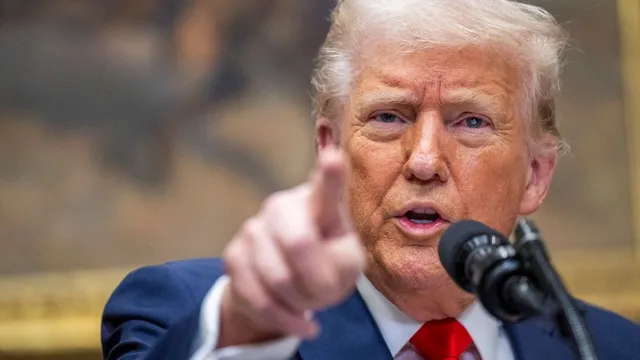
Donald Trump threatens unprecedented 200% tariff on European wines
2025-03-13 20:20- President Trump threatened a 200% tariff on European wine, Champagne, and spirits in early March 2025.
- This threat is a response to the EU's planned 50% tariff on American whiskey.
- European producers are alarmed at the potential devastation to their exports, highlighting the interconnected nature of global trade.
Express your sentiment!
Insights
In early March 2025, President Donald Trump announced a significant escalation in the ongoing trade tensions between the United States and European Union, specifically targeting European wine, Champagne, and spirits. This threat comes as a direct response to the EU's planned 50% tariff on American whiskey, which was unveiled following Trump's tariffs on steel and aluminum imports. European producers, particularly from France, Italy, and Spain, fear this escalation could devastate their exports to the U.S., which were previously worth around 4 billion euros annually. The impact of such a tariff would not only halt exports but could fundamentally reshape the American alcoholic beverage market, where European products account for 17% of consumption. As a protective measure, producers from these countries have actively sought exemptions from potential retaliatory tariffs, signaling their alarm at the possible adverse effects on their industries. The historical context of the trade relationship reveals painful memories of previous sanctions that resulted in a 40% drop in French wine sales in the U.S. during Trump's first term. The threat of a 200% tariff is viewed as devastating, as industry experts suggest no customer would be willing to purchase products at such inflated prices. The U.S. market's reliance on European wines creates a dilemma, showcasing the interconnected nature of global trade and manufacturing. Negotiations between U.S. and EU representatives are expected to center around avoiding additional tariffs and finding common ground that benefits both parties. However, the current political climate suggests that both sides may be entrenched in their positions, complicating any potential discussions aimed at reducing tensions. This situation not only jeopardizes exports for European producers but also raises concerns about increasing costs for American importers and consumers who enjoy these products, ultimately creating broader economic implications on both sides of the Atlantic. While Trump insists that these tariffs are intended to bolster American manufacturing and rein in foreign trade practices perceived as unfair, critics argue that such measures disproportionately harm consumers and disrupt established markets. The outcome of these negotiations and the proposed tariffs may be critical in shaping future trade relations between the U.S. and EU, making it imperative for both sides to consider the repercussions of their actions in the complex web of international trade dynamics, especially within the politically sensitive landscape surrounding the alcohol industry.
Contexts
The history of U.S. tariffs on alcohol is marked by significant changes in tax policy, economic interests, and social movements. Beginning in the early years of the republic, the federal government imposed tariffs on imported beverages, including spirits, as a means of raising revenue. The Tariff Act of 1789, the first federal law aimed at taxing imports, included duties on various goods, although it notably did not specifically target alcohol in significant form at that time. It wasn't until the late 19th century that tariffs on alcohol began to be a more significant aspect of federal revenue, particularly with the growth of the brewing industry and the rising popularity of spirits among the American populace. As alcohol importation increased, so did government interest in regulating and taxing it, leading to a more structured tariff approach in the decades to follow. The introduction of the federal income tax in 1913 and the subsequent prohibition era from 1920 to 1933 altered the landscape of alcohol tariffs. During Prohibition, the production, importation, and sale of alcoholic beverages were banned, which led to a dramatic decrease in tax revenue derived from alcohol. However, the repeal of Prohibition with the 21st Amendment in 1933 marked a resurgence in both the production and taxation of alcoholic beverages. Shortly after, the federal government enacted tariffs on imported alcohol, which served not only as a means of generating revenue but also to protect domestic producers from foreign competition. This period saw a steady increase in the federal excise tax on alcohol, aimed at generating income for the government while also controlling consumption. In the following decades, U.S. tariffs on alcohol fluctuated with changing political landscapes, economic pressures, and public attitudes toward alcohol consumption. Tariff policies were often used as tools for protecting local industries, particularly as the craft brewing movement gained momentum in the late 20th century. As globalization expanded, American producers faced new challenges from imports, leading to calls for protective tariffs and measures to ensure that domestic alcohol remained competitive in pricing and quality. Notably, trade agreements in the 1990s and early 2000s complicated tariff structures by creating situations where some imported alcohol faced lower rates due to international trade agreements, further impacting domestic producers. Today, tariffs on alcohol remain a significant subject in discussions about trade policy and economic strategy. State and federal tariffs on alcohol are a complex mix of sets, including excise taxes and import tariffs, which can vary significantly between types of beverages, such as beer, wine, or spirits. In recent years, debates have intensified regarding the economic implications of tariffs in the context of free trade and the protection of domestic markets. As consumer preferences continue to shift, and the craft beverage movement grows, the U.S. government continues to navigate the balance between fostering domestic industry and maintaining fair competition on the global stage. The history of U.S. tariffs on alcohol exemplifies the broader tensions between economic interests, social policies, and international trade relations.